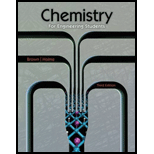
Concept explainers
Interpretation: types of corrosion and its reaction mechanism
Conceptual introduction: When metal is exposed to certain environment it get deteriorated because of the reaction occurring between environment and metal surface. The surface becomes uneven and rough and weak.
Example of corrosion: loss of silver shine, green layer formed on copper and bronze.
Answer to Problem 1CO
Solution:
There are various type of corrosion pit formation, crevice corrosion and galvanic corrosion. Reaction occurring there is
Explanation of Solution
There are different types of corrosion:
Pitting corrosion: is the most destructive type of corrosion. It can deteriorate the metal to level where holes and pits are formed on the surface of metal. It is the localised type of corrosion. Pits penetrate vertically. It can deteriorate the complete structure. Main reason for this type of corrosion is the uneven surface if metal.
These are of following types:
a) Narrow deep cuts goes deeply in the metal structure.
b) Shallow and wide: upper area suffers the destruction
c) Undercutting: upper layer remain intact but layer below it de grades.
d) Subsurface: where on surface shows a small hole but deep inside the metal a large area is been rusted.
Crevice corrosion: is localised form of corrosion. It occurs on the metal surface which do not have equal concentration of metal ions at all the places. It occurs at bolt heads, gaskets, etcpalces where metal surface is covered with another type of surface which promotes rusting. At the point of contact the pH shifts from neutral. Since it occurs at the point of joining the proper construction of joints can reduce this type of corrosion. This type of corrosion occurs at very low temperature.
Galvanic Corrosion: is degradation of metal surface where two electrochemically dissimilar metals are joined and are in electrical contact in electrolytic environment. Joining metals which are close on galvanic series help in reducing the risk of galvanic corrosion.
Mechanism of rusting is similar in all kind of corrosion form just surface appearance is different.
According to
Anodic area:
Oxidation occurs and iron atoms get oxidised to Fe2+ ions.
The electrons released moves through the metal to the cathode area. In cathode area the electrons reduces the oxygen in the presence of H+ ions. H+ions are formed in the water due to the dissociation of
In water film reaction:
In the cathode area:
Overall reaction is:
There are various types of corrosion pit formation, crevice corrosion and galvanic corrosion. Reaction occurring there is
Want to see more full solutions like this?
Chapter 13 Solutions
Chemistry for Engineering Students
 Chemistry for Engineering StudentsChemistryISBN:9781337398909Author:Lawrence S. Brown, Tom HolmePublisher:Cengage Learning
Chemistry for Engineering StudentsChemistryISBN:9781337398909Author:Lawrence S. Brown, Tom HolmePublisher:Cengage Learning World of Chemistry, 3rd editionChemistryISBN:9781133109655Author:Steven S. Zumdahl, Susan L. Zumdahl, Donald J. DeCostePublisher:Brooks / Cole / Cengage Learning
World of Chemistry, 3rd editionChemistryISBN:9781133109655Author:Steven S. Zumdahl, Susan L. Zumdahl, Donald J. DeCostePublisher:Brooks / Cole / Cengage Learning Introductory Chemistry: A FoundationChemistryISBN:9781285199030Author:Steven S. Zumdahl, Donald J. DeCostePublisher:Cengage Learning
Introductory Chemistry: A FoundationChemistryISBN:9781285199030Author:Steven S. Zumdahl, Donald J. DeCostePublisher:Cengage Learning Chemistry: The Molecular ScienceChemistryISBN:9781285199047Author:John W. Moore, Conrad L. StanitskiPublisher:Cengage LearningChemistry: Matter and ChangeChemistryISBN:9780078746376Author:Dinah Zike, Laurel Dingrando, Nicholas Hainen, Cheryl WistromPublisher:Glencoe/McGraw-Hill School Pub Co
Chemistry: The Molecular ScienceChemistryISBN:9781285199047Author:John W. Moore, Conrad L. StanitskiPublisher:Cengage LearningChemistry: Matter and ChangeChemistryISBN:9780078746376Author:Dinah Zike, Laurel Dingrando, Nicholas Hainen, Cheryl WistromPublisher:Glencoe/McGraw-Hill School Pub Co Living By Chemistry: First Edition TextbookChemistryISBN:9781559539418Author:Angelica StacyPublisher:MAC HIGHER
Living By Chemistry: First Edition TextbookChemistryISBN:9781559539418Author:Angelica StacyPublisher:MAC HIGHER





